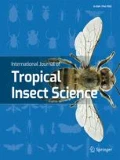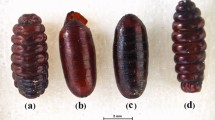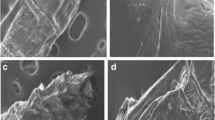Abstract
The present study aimed to evaluate the efficacy of the methanolic extract of Enteromorpha compressa against the 3rd larval stages and adults of Musca domestica and Calliphora vicina. Three concentrations of the methanolic extract of E. compressa (5, 10, and 20) g/L are used. The results showed that the mortality of M. domestica larvae varied from 26.6%, 66.6% to 100% at the concentration of 5 g/L, 10 g/L, and 20 g/L respectively after 24 h of treatment, but after 48 h at the same concentration, the mortality were 33.3%, 76.6%, and 100% respectively. The LC50 are 7.179 g/L for 24 h and 6.469 g/L for 48 h of treatment. The mortality of M. domestica adults were 33.3%, 46.6%, and 73.3% at the concentrations of 5 g/L, 10 g/L, and 20 g/L respectively after 24 h, and at the same concentration of extract, there were mortality about 43.3%, 66.6%, and 100% after 48 h respectively. The LC50 were 9.653 g/L for 24 h and 6.230 g/L for 48 h. The mortality of C. vicina larvae were 10%, 46.6%, and 83.3% at 5 g/L, 10 g/L, and 20 g/L concentrations respectively after 24 h and 23.3%, 53.3% and 90% after 48 h. The LC50 for larvae was 10.909 g/L for 24 h and 8.678 g/L for 48 h. The mortality of C. vicina adults were 20%, 33.3%, and 56.6% at concentrations of 5 g/L, 10 g/L, and 20 g/L at 24 h, and 43.3%, 63.3%, and 86.6% at 48 h. The LC50 for adult C. vicina were 16.778 g/L for 24 h and 6.368 g/L for 48 h after treatment.










Similar content being viewed by others
References
Abbott WS (1925) A method of computing the effectiveness of an insecticide. J Econ Entomol 18(2):265–267
Ahmed KM (2018) The effect of aqueous plant extracts of tobacco on third larvae of house fly (Musca dmestica L., (Diptera: Muscide). J Entomol Zool Stud 6(3):403–408
Alade PI, Irobi ON (1993) Antimicrobial activities of crude leaf extracts of Acalypha Wilkesiana. J Ethnopharmacol 39(3):171–174
Alghazeer R, Fauzi W, Entesar A, Fatiem G, Salah A (2013) Screening of antibacterial activity in marine green, red and Brown macroalgae from the Western coast of Libya. Nat Sci 5(1):7–14
Ande AT (2001) Biological activities of some plant materials against the housefly–Musca Domestica. Niseb J 1(4):293–296
Axtell RC, Arends JJ (1990) Ecology and management of arthropod pests of poultry. Annu Rev Entomol 35(1):101–126
Barreto M, Mendonça E, Gouveia V, Anjos C, Medeiros JS, Seca AML, Neto AI (2012) Macroalgae from S. Miguel Island as a Potential Source of Antiproliferative and Antioxidant Products. Arquipelago Life Mar Sci 29:53–58
Bellés X, Martín D, Piulachs MD (2005) The Mevalonate pathway and the synthesis of juvenile hormone in insects. Annu Rev Entomol 50:181–199
Butler JF, Alejandra G, Frank M, James E (2010) Wild Florida house flies (Musca Domestica) as carriers of pathogenic Bacteria. Fla Entomol 93(2):218–223
Chapagain B, Wiesman Z (2005) Larvicidal effects of aqueous extracts of Balanites Aegyptiaca (desert date) against the larvae of Culex Pipiens mosquitoes. Afr J Biotechnol 4(11):1351–1354
Francis G, Zohar K, Harinder P, Makkar S, Klaus B (2002) The biological action of Saponins in animal systems: A review. Br J Nutr 88(6):587–605
Halawa ZA, Mohamed RA, El-Kashlan II (1998) Laboratory evaluation plant and insecticides against beetle Callobruchus maculates infesting stored product. Eygpt J Agr Res 79(1):85–93
Johnson M, Raja PD (2015) Bio-efficacy of green seaweeds from South East Coast of Tamil Nadu, India. J Microbiol Experiment 2(2):1–7
Kačmár P, Pistl J, Mikula I (1999) Immunotoxicology and veterinary medicine. Acta Vet Brno 68(1):57–79
Kareem DK, Mustafa FAJ, Al-Edany AAS (2011) The effect of alcoholic extracts of Juncus rigidus and stem of Capparis spinosa on the larval and pupal instar of the meat fly Calliphora vicina rob. Desvoidy (1830)(Calliphoridae: Diptera). Univ Thi-Qar J Sci 3(1):48–56 (In Arabic)
Khamesipour F, Lankarani KB, Honarvar B, Kwenti TE (2018) A systematic review of human pathogens carried by the housefly (Musca domestica L.). BMC Public Health 18(1):1049–1063
Koul O, Walia S (2009) Comparing impacts of plant extracts and pure allelochemicals and implications for pest control. CAB Rev: Perspect Agric Veterin Sci Nutr Natural Resourc 4(049):1–30
Kumar L, Mahatma MK, Kalariya KA, Bishi SK, Mann A (2014) Plant Phenolics: important bio-weapon against pathogens and insect herbivores. Pop Kheti 2(3):149–152
Mariya V, Ravindran VS (2013) Biomedical and pharmacological significance of marine macro algae-review. Indian J Mar Sci 42(5):527–537
Miller LC, Tainter M (1944) Estimation of the ED50 and its error by means of logarithmic-Probit graph paper. Proc Soc Exp Biol Med 57(2):261–264
Mullen GR, Durden LA (2019) Medical and veterinary entomology, 3rd edn. Academic Press, Cambridge, p 769
Paiva LS, Patarra RF, Neto AI, Lima EMC, Baptista JAB (2012) Antioxidant activity of macroalgae from the Azores. Arquipelago. Life Mar Sci 29:1–6
Pavela R (2013) Efficacy of Naphthoquinones as insecticides against the house Fly, Musca Domestica L. Ind Crop Prod 43:745–750
Pino O, Sánchez Y, Rojas M M (2013) Plant secondary metabolites as an alternative in Pest management. I: background, Res Approach Trends Revista de Protección Vegetal 28(2):81–94
Prasanna Latha D. Hema Latha KPJ (2011) Antimicrobial activity of the chloroform extracts of the Chlorophycean seaweeds Enteromorpha Compressa and Chaetomorpha Antennina. Int Res J Microbiol (IRJM) 2(8):249–252
Raman BV, Rao DN, Radhakrishnan TM (2004) Enteromorpha compressa (L.) Greville an edible green alga as a source of antiallergic principle (S). Indian J Clin Biochem 19(1):105–109
Ray B (2006) Polysaccharides from Enteromorpha Compressa: isolation, purification and structural features. Carbohydr Polym 66(3):408–416
Regnault-Roger C, Vincent C, Arnason JT (2012) Essential oils in insect control: low-risk products in a high-stakes world. Annu Rev Entomol 57:405–424
Rockstein M (1978) Biochemistry of insects. Academic Press, Cambridge, p 649
Sakunthala M, Paul J (2019) Characterization of Phytochemicals in Methanolic Extract of Enteromorpha compressa ( L .) Nees Collected from Kanyakumary Coast of Tamil Nadu, India. J Drug Deliv Therap 9(3-s):649–653
Saranya C, Parthiban C, Anantharaman P (2014) Evaluation of antibacterial and antioxidant activities of seaweeds from Pondicherry coast. Adv Appl Sci Res 5(4):82–90
Shaalan EAS, Canyon D, Younes MWF, Abdel-Wahab H, Mansour AH (2005) A review of botanical phytochemicals with mosquitocidal potential. Environ Int. Elsevier 31(8):1149–1166
Shanab SM, Shalaby EA, El-Fayoumy EA (2011) Enteromorpha compressa exhibits potent antioxidant activity. J Biomed Biotechnol 2011:1–11. https://doi.org/10.1155/2011/726405
Soulsby EJL (1982) Helminths, arthropods and Protozoa of domesticated animals, Balliere Tindall. The English Language Book Society, London
Sukontason KL, Boonchu N, Sukontason K, Choochote W (2004) Effects of eucalyptol on house Fly (Diptera: Muscidae) and blow Fly (Diptera: Calliphoridae). Rev Inst Med Trop Sao Paulo 46(2):97–101
Sukontason KL, Bunchoo M, Khantawa B, Piangjai S, Rongsriyam Y, Sukontason K (2007) Comparison between Musca Domestica and Chrysomya Megacephala as carriers of Bacteria in northern Thailand. Southeast Asian J Trop Med Public Health 38(1):38–44
Sultana V, Baloch GN, Ara J, Ehteshamul-Haque S, Tariq RM, Athar M (2011) Seaweeds as an alternative to chemical pesticides for the Management of Root Diseases of sunflower and tomato. J Appl Bot Food Qual 84(2):162–168
Suresh M, Premraj L, Kalaiarasi JMV (2017) Bioefficacy and larvicidal activity of Couroupita guianensis (Aubl) against housefly, Musca domestica (L). J Entomol Zool Stud 5(5):429–433
Tunaz H, Uygun N (2004) Insect growth regulators for insect Pest control. Turk J Agric For 28(6):377–387
Wall RL, Shearer D (2001) Veterinary Ectoparasites: biology, pathology and control, 2nd edn. Blackwell scince ltd.UK pp 262
Walsh SB, Dolden TA, Moores GD, Kristensen M, Lewis T, Devonshire AL, Williamson MS (2001) Identification and characterization of mutations in housefly (Musca Domestica) Acetylcholinesterase involved in insecticide resistance. Biochem J 359(1):175–181
Zhu F, Lavine L, O’Neal S, Lavine M, Foss C, Walsh D (2016) Insecticide resistance and management strategies in urban ecosystems. Insects 7(2):1–26
Acknowledgments
The authors would like to thank Prof. Emad Y. Al- Awad for his support in some aspects of this research.
Author information
Authors and Affiliations
Corresponding author
Ethics declarations
Conflict of interest
On behalf of all authors, the corresponding author states that there is no conflict of interest.
Additional information
Publisher’s note
Springer Nature remains neutral with regard to jurisdictional claims in published maps and institutional affiliations.
Rights and permissions
About this article
Cite this article
Al-Jaber, G.T., Hatem, A.N. Larvicidal and Adulticidal potential of the green alga Enteromorpha compressa extracts against Musca domestica and Calliphora vicina (Diptera: Muscidae, Calliphoridae). Int J Trop Insect Sci 41, 1147–1154 (2021). https://doi.org/10.1007/s42690-020-00299-1
Received:
Accepted:
Published:
Issue Date:
DOI: https://doi.org/10.1007/s42690-020-00299-1




